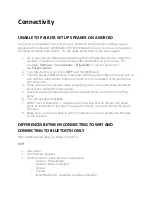
© Hybrid Audio Technologies, 2010
Page 18 of 22
Lesson Five: Reference
One of the most important things to do before completing your Imagine installation is to get a
reference for your future listening tests. To really know what a snare drum sounds like, you
must go and listen to one, in person, live and un-amplified. There is no substitute for the
visceral impact and emotion of live music. Nothing else in life can touch your soul the way
music does. Whether it’s a 200-member orchestra, or a four-piece fusion band, nothing
compares to the phenomenon of live music.
Take this as Hybrid Audio’s official request: become a student of music and your mobile audio
sound system will be better for it. We want nothing more than to know there are great
sounding audio systems around the world using our products, and you’d make us all very
proud if you became a student of music and learned its beauty and passion.
Advanced Installation of the Imagine Component Systems
Mounting Baffle Considerations
Now that we have revealed five of our most important “Lessons Learned”, we can now apply
these lessons to the Imagine installation. The first important matter is the physical installation
of your Imagine midbass, and more specifically with respect to improving the Imagine
midbass’ mounting baffles. Most vehicles’ factory mounting locations for speakers are less
than ideal. In most cases, the OEM speaker mounting flanges are likely nothing more than
flimsy extruded plastic, and provide no sonic benefit to your Imagine installation. The Imagine
drivers are long-throw midbass, and the plastic mounting baffles that come from the factory in
virtually every vehicle will lead to buzzes, rattles, vibrations, and resonances, all of which
negatively effect the Imagine installation. In other vehicles, you may have attached the
Imagine midbass’ directly to the door metal (hopefully with a layer or two of self-adhesive
sound damping in between), but this is still not entirely ideal. In whatever scenario you have
installed your Imagine midbass, there are certain “tricks” and techniques that may be applied
to get the most out of your Imagine component set, specifically the midbass installation, as
follows:
•
Mounting the baffle, sound damping, and “decoupling”
: the mounting baffle or
mounting location should either be secured extremely well to the vehicle’s body, or
completely isolated from the vehicle’s chassis. The reasoning is that the speaker baffle
panel will vibrate and will radiate sound. Even small vibrations can result in the baffle
itself radiating more sound than the actual speaker at certain frequencies. The
mounting baffle or mounting location should be damped with a layer of typical sound
damping to reduce the Q of the baffle and lower its vibration resonance frequency
below the range of the driver’s frequency response. In many cases, using thicker baffle
panel in concert with self-adhesive sound damping can also be advantageous, provided
the rearward wave of the speaker has no obstructions created by the baffle itself.
Finally, if possible, the speaker should be mechanically decoupled from the baffle. This
can be something as simple as a layer of self-adhesive foam tape, to more exotic
examples of decoupling, including rubberized rings or multiple-layer septum shielding.





































